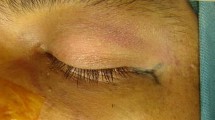Abstract
Objective
This study aimed to present a minimally invasive surgical management of zygomaticomaxillary complex (ZMC) fractures with reduction and single-point stabilization over the frontozygomatic buttress.
Methods
This prospective cohort study was conducted on cases of ZMC fractures. The inclusion criteria were displaced tetrapod zygomatic factures, asymmetry of the facial bones, and unilateral lesion. The exclusion criteria were extensive skin or soft tissue loss, comminuted inferior orbital rim, limited ocular mobility, and enophthalmos. Surgical management included reduction and single-point stabilization over the zygomaticofrontal suture with miniplates and screws. The outcome measure was correction of the clinical deformity with less scarring and low postoperative morbidity. The late outcome was maintenance of a stable fixed reduced zygoma over the follow-up period.
Results
Forty-five patients were included in the study with a mean age of 30 ± 5.56 years. The study included 40 men and 5 women. Motor vehicle accident was the most common cause of fracture (62.2%). They were managed via lateral eyebrow approach with single-point stabilization over the frontozygomatic suture after reduction. Preoperative and postoperative and radiologic images were available. All cases had optimum correction of the clinical deformity. Postoperative stability was excellent in the follow-up period, which had a mean of 18.5 ± 7.81 months.
Conclusion
There is an increased interest in minimally invasive procedures, and concerns about scarring have increased. Therefore, single-point stabilization over the frontozygomatic suture provides good support to the reduced ZMC with low morbidity.







Similar content being viewed by others
References
Kim SY, Nam SM, Park ES, Kim YB (2019) Evaluation of one-point fixation for zygomaticomaxillary complex fractures using a three-dimensional photogrammetric analysis. J Otolaryngol Head Neck Surg 48(1):36
Malaviya P, Choudhary S (2018) Zygomaticomaxillary buttress and its dilemma. J Korean Assoc Oral Maxillofac Surg 44(4):151–158
Starch-Jensen T, Linnebjerg LB, Jensen JD (2018) Treatment of zygomatic complex fractures with surgical or nonsurgical intervention: a retrospective study. Open Dent J 12:377–387
Nezafati S, Mortazavi A, Arta SA, Yazdani J, Ghanizadeh M (2018) Treatment and complications of patients with zygomatic fractures. Trauma Mon 23(5)
Kumar Punjabi DS, Ali Channar DK, Ahmed Banglani DM, Kumar DN, Munir DA (2016) Isolated zygomatic bone fracture; management by three point fixation. Prof Med J 23(5):526–530
Ashwin DP, Rajkumar GC (2017) A study on assessing the etiology and different treatment modalities of zygomaticomaxillary complex fracture. IJCMR 4(6):1423–1430
Yamsani B, Gaddipati R, Vura N, Ramisetti S, Yamsani R (2016) Zygomaticomaxillary complex fractures: a review of 101 cases. J Maxillofac Oral Surg 15(4):417–424
Strong EB, Gary C (2017) Management of zygomaticomaxillary complex fractures. Facial Plast Surg Clin North Am 25(4):547–562
Gadkari N, Bawane S, Chopra R, Bhate K, Kulkarni D, Resident Y et al (2019) Comparative evaluation of 2-point vs 3-point fixation in the treatment of zygomaticomaxillary complex fractures: a systematic review. J CraniomaxillofacSurg 47(10):1542–1550
Sridhar P, Sandeep S, Prasad K, Lalitha RM, Ranganath K 2017 Comparative evaluation of single point fixation at zygomatic buttress and fronto zygomatic rim in zygomatic complex fractures: a prospective Study. JDOR 13(2)
Forouzanfar T, Salentijn E, Peng G, Van Den Bergh B (2013) A 10-year analysis of the “Amsterdam” protocol in the treatment of zygomatic complex fractures. J Craniomaxillofac Surg 41(7):616–622
Calderoni DR, Guidi Mde C, Kharmandayan P, Nunes PHF (2011) Seven-year institutional experience in the surgical treatment of orbito-zygomatic fractures. J Craniomaxillofac Surg 39(8):593–599
Dakir A, Muthumani T, Prabu NP, Mohan R, Maity A (2015) One point fixation of zygomatic tripod fractures in the zygomatic buttress through Keen’s intraoral approach: a review of 30 cases. J Pharm Bioallied Sci 7(Suppl 1):S238–S241
Ji SY, Kim SS, Kim MH, Yang WS (2016) Surgical methods of zygomaticomaxillary complex fracture. Arch Craniofac Surg 17(4):206–210
Mohammadinezhad C (2009) Evaluation of a single miniplate use in treatment of zygomatic bone fracture. J Craniofac Surg 20(5):1398–1402
Knight JS, North JF (1961) The classification of malar fractures: an analysis of displacement as a guide to treatment. Br J Plast Surg 13:325–339
Hwang K (2010) One-point fixation of tripod fractures of zygoma through a lateral brow incision. J Craniofac Surg 21(4):1042–1044
Thangavelu K, Ganesh NS, Kumar JA, Sabitha S (2013) Evaluation of the lateral orbital approach in management of zygomatic bone fractures. J Nat SciBiol Med 4(1):117–121
Kovács AF, Ghahremani M (2001) Clinical paper: trauma Minimization of zygomatic complex fracture treatment. Int J Oral Maxillofac Surg 30(5):380–383
Parashar A, Sharma RK, Makkar S (2018) Rigid internal fixation of zygoma fractures: a comparison of two-point and three-point fixation. PlastSurg 40(1):18–123
Ahn SK, Wee SY (2019) Oroantral fistula after a zygomaticomaxillary complex fracture. Arch Craniofac Surg 20(3):212–216
Huang W, Lynham A, Wullschleger M (2015) Orbitozygomatic fracture repairs: Are antibiotics necessary? Craniomaxillofac Trauma Reconstr 8(4):271–276
Funding
The authors declared that this study has received no financial support.
Author information
Authors and Affiliations
Corresponding author
Ethics declarations
Conflict of interest
The authors have no conflict of interest to declare.
Ethical Approval
The study performance was in accordance with the ethical standards of the institutional and/or national research committee with a number of RP.19.11.48 and with the 1964 Declaration of Helsinki and its later amendments or comparable ethical standards.
Informed Consent
Informed consent was obtained from all individual participants included in the study.
Additional information
Publisher's Note
Springer Nature remains neutral with regard to jurisdictional claims in published maps and institutional affiliations.
Rights and permissions
About this article
Cite this article
Elkahwagi, M., Eldegwi, A. Minimally Invasive Single-Point Stabilization of Zygomaticomaxillary Complex Fractures. J. Maxillofac. Oral Surg. 21, 1355–1362 (2022). https://doi.org/10.1007/s12663-021-01520-5
Received:
Accepted:
Published:
Issue Date:
DOI: https://doi.org/10.1007/s12663-021-01520-5




